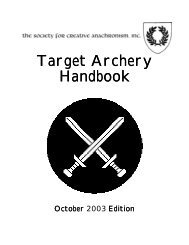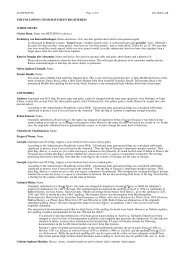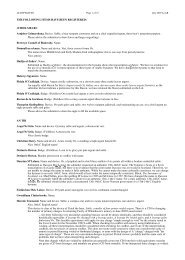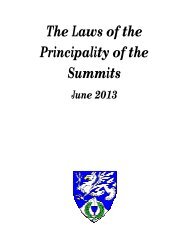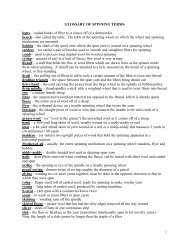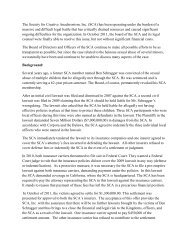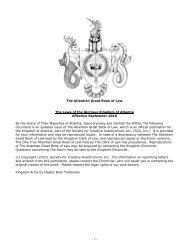The Standards for Evaluation of Names and Armory - SCA Heraldry
The Standards for Evaluation of Names and Armory - SCA Heraldry
The Standards for Evaluation of Names and Armory - SCA Heraldry
Create successful ePaper yourself
Turn your PDF publications into a flip-book with our unique Google optimized e-Paper software.
<strong>The</strong> <strong>St<strong>and</strong>ards</strong> <strong>for</strong> <strong>Evaluation</strong> <strong>of</strong> <strong>Names</strong> <strong>and</strong> <strong>Armory</strong>:<strong>The</strong> Rules <strong>for</strong> SubmissionsAppendix A: Patterns That Do Not Need Further Documentation by Language GroupThis appendix lists patterns <strong>for</strong> naming that do not need further documentation. For the patterns listed below, mention <strong>of</strong> the pattern <strong>and</strong> <strong>of</strong> this appendix is sufficient todocument the pattern. Patterns not listed here need further documentation, <strong>of</strong>ten including examples. For languages not listed here, all patterns must be documented.Bynames in many <strong>of</strong> these languages require grammatical changes to elements. Those changes are not explained here; refer to the listed sources <strong>for</strong> instructions oncreating the correct <strong>for</strong>ms. Each element within this construction must still be documented. Any grammatical changes must be documented as well.For more in<strong>for</strong>mation about types <strong>of</strong> bynames, refer to Appendix B.In the table below, name patterns are written using a consistent system:• N is the given name <strong>of</strong> the person bearing the name in the nominative case.• B, C, etc. are the given names <strong>of</strong> relatives or ancestors <strong>of</strong> the person bearing the name.• X is used to indicate a place name or region; Y is used to indicate a generic toponym (e.g., 'the woods' or 'the dell'); Z is used to indicate the charge or other namein an inn-sign type location (e.g., star or lion).• Unmarked means "using the element – location, father's name, etc. – in an unmodified <strong>for</strong>m as a byname;" marked <strong>for</strong> bynames means using a term such as "son"or "daughter" <strong>of</strong>ten with a modified <strong>for</strong>m <strong>of</strong> the father's name. Using a modified <strong>for</strong>m <strong>of</strong> the father's name without any other marker is labeled as "genitivealone."• In "order," byname means "any byname described to the left." Pat = patronymic byname; Loc = locative bynameFor example, N filius B would be 'N, the son <strong>of</strong> B' or 'N, B's son'. N de X would be "N from X".Boxes that are unmarked or patterns not listed require further documentation to use that pattern. "Rare" means that such names are sufficiently rare that a constructed, asopposed to attested version, <strong>of</strong> such a byname generally requires the help <strong>of</strong> an expert in that language to determine if it is plausible.ArabicDoubleGiven<strong>Names</strong>Locative Patronymic Other relationship Descriptive/OccupationalDictus DoubleBynamesOrderArabic No Adjectival;al-[adjectival<strong>for</strong>m <strong>of</strong> placename].For men ibn B "son<strong>of</strong> B"<strong>for</strong> women bint B"daughter <strong>of</strong> B"Multi-generationalpatronymics; AbūB <strong>and</strong> Umm B(where B is thechild’s name)al-[occupationor descriptionor ethnicgroup]Notes: Locative <strong>and</strong> descriptive bynames must match the gender <strong>of</strong> the person described; see articles below <strong>for</strong> more details.No Yes Multiple possible variations; seearticles below <strong>for</strong> morein<strong>for</strong>mationDiacritics (long marks, emphatic marks, etc.) may be used or omitted as long as it is done consistently; see Appendix D <strong>for</strong> more details about transliteration.Please refer to Juliana de Luna, "Arabic <strong>Names</strong> from al-Andalus" (http://www.s-gabriel.org/names/juliana/al<strong>and</strong>alus/) or Da'ud ibn Auda, "Period Arabic <strong>Names</strong> <strong>and</strong>Naming Practices" (http://heraldry.sca.org/laurel/names/arabic-naming2.htm) <strong>for</strong> additional in<strong>for</strong>mation.Rules <strong>for</strong> Submissions - January, 2012



